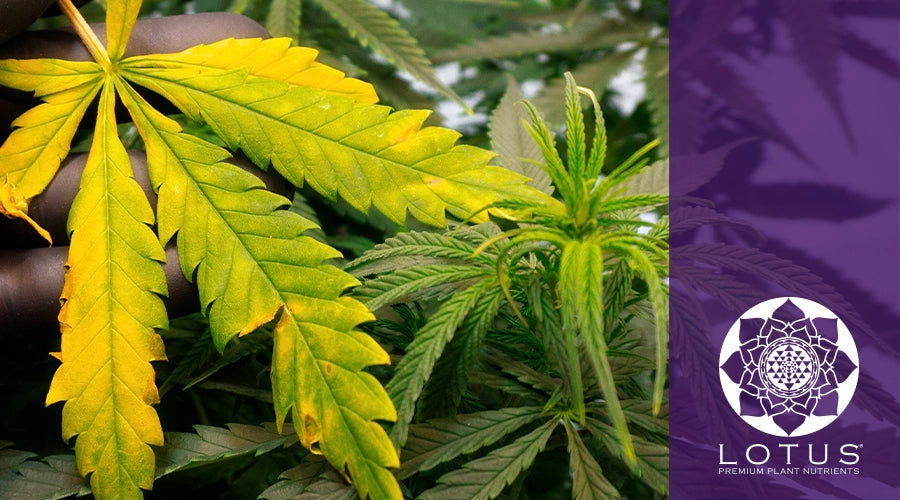
The Top 5 Reasons Your Cannabis Plants Are Turning Yellow and How to Fix It
In this short article, we'll cover some of the main problems that can cause cannabis plants to turn yellow and how to fix them. The five most well-known causes of yellowing in the cannabis plant are as follows.

Yellowing Cannabis Leaves?
Nutritional Deficiencies:
If your cannabis plants are turning yellow, it may be due to a lack of one or more essential nutrients such as nitrogen, phosphorus, or potassium. To remedy this, you can use a balanced nutrient solution, adjust the pH of the soil or water, and provide adequate drainage.
Overwatering:
Overwatering can lead to waterlogged soil and root rot, which can cause yellowing leaves. To remedy this, allow the soil to dry out a bit and provide proper drainage before watering again.
Underwater:
Underwater can cause leaves to turn yellow and dry. To fix this, water your plants regularly and make sure you don't overwater them.
Pest Infestation:
Pests such as spider mites, aphids, or thrips can cause yellowing and spotting on cannabis leaves. To remedy this, use natural or chemical pesticides, depending on your preference, and isolate diseased plants to prevent further infestation.
pH Imbalance:
An incorrect pH level can cause nutrient deficiencies, causing leaves to turn yellow. To fix this, check the pH of your soil or water and adjust it to the appropriate range for cannabis growth.
To prevent problems such as the yellowing of leaves, you should regularly monitor and care for your cannabis plants. However, if problems persist despite your best efforts, be sure to seek advice from a professional breeder.
Importance of Nutrient Cycle in Cannabis Plant Nutrition
The nutrient cycle is what you need to consider the most for the growth and development of the cannabis plant. When we say nutrient cycle, we must understand the process by which nutrients are recycled and reused within the ecosystem. In other words, nutrients are taken up by plants, used for growth and development, and then released back into the soil or ecosystem where other plants can take them.
Nutrient cycling is particularly important in cannabis cultivation because the cannabis plant needs a variety of nutrients to grow and thrive. These nutrients include macronutrients such as nitrogen, phosphorus, and potassium and micronutrients such as iron, zinc, and magnesium. Without proper nutrient cycling, the cannabis plant can suffer from nutrient deficiencies or toxicities that can lead to stunted growth, low yields, and other problems.
Nutrient cycling can occur naturally in cannabis cultivation outdoors, as plants take nutrients from the soil and release them back into the ecosystem. However, nutrient cycling in indoor cannabis cultivation must be actively managed through techniques such as composting, worm farming, and other forms of organic matter recycling.
Maximizing Yield and Quality: The Role of Nutrient Cycling in Cannabis Cultivation
Let's take a look at the benefits of properly planned nutrient cycling in cannabis cultivation.
Increased nutrient availability:
The nutrient cycle ensures that nutrients are available to plants in a form they can use. When nutrients are released back into the soil through natural processes or composting, they are broken down into a form that plants can take up.
Reduced food waste:
Nutrient cycling reduces food waste by allowing nutrients to be reused rather than lost through runoff or other forms of waste.
Improved soil health:
Nutrient cycling improves soil health by increasing soil organic matter and promoting beneficial microbial activity. This can lead to better nutrient uptake and overall plant health.
Sustainable cultivation:
Nutrient cycling is an important component of sustainable cannabis cultivation. By reusing nutrients, growers can reduce their dependence on synthetic fertilizers and other unsustainable inputs.
Improved water retention:
Nutrient cycling can increase the water-holding capacity of the soil by increasing the organic matter content. This can help the cannabis plant survive drought conditions and reduce the need for irrigation.
Reduced soil erosion:
Nutrient cycling can also help reduce soil erosion by improving soil structure and stability. This is especially important in outdoor cannabis cultivation, where soil erosion can be a big problem.
Reduced environmental impact:
Proper nutrient cycling can help reduce the environmental impact of hemp cultivation by reducing the amount of synthetic fertilizers and other inputs needed. This can also help reduce the risk of nutrient runoff and contamination of nearby water sources.
Improved flavor and aroma:
Proper nutrient cycling can also enhance the flavor and aroma of cannabis plants by promoting the production of terpenes and other aromatic compounds.
